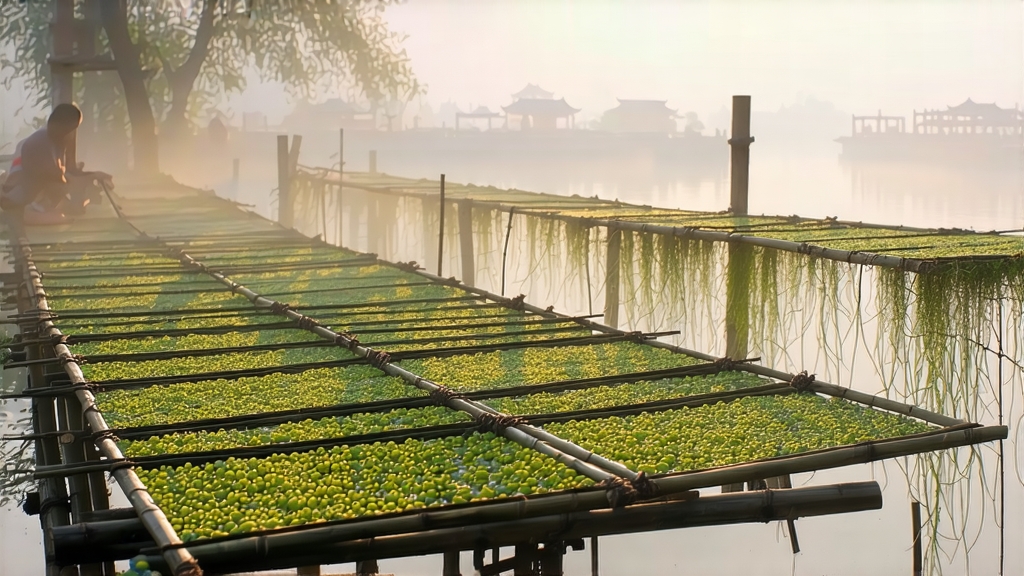
Tucked between the mist-laden hills of Dongting Mountain and the gentle ripples of Taihu Lake in Jiangsu Province, Biluochun—literally “Green Snail Spring”—has been seducing tea lovers since the late Ming dynasty. According to local chronicles, a tea picker in 1675 caught the fragrance of an extraordinary leaf drifting through an abandoned orchard of peach and apricot. Following the scent, she discovered tiny jade spirals clinging to the branches. The imperial court soon christened the tea “Xia Sha Ren Xiang” (“Scary-fragrant”), later softened to Biluochun when the Kangxi Emperor, charmed by its rolled snail-shell shape, bestowed the elegant name we use today.
Biluochun is not a single cultivar but a micro-terroir family. The original “Dongting Original Species” (Dongting Qunti) still grows wild on rocky islets, surviving on morning mist and mineral-rich lake air. Commercial gardens favor the cloned “Dongting #1” for higher yield, while eco-farmers experiment with “Fuding White #1” grafted onto local rootstock, yielding a creamier liquor. Each strain is picked within a 30-day window that begins when lake mist lifts just enough to reveal the first apical bud plus the immediate leaf—standard pluck is one centimeter, no larger than a housefly.
Crafting Biluochun is a dance of heat and fingertips performed the same day the leaf is picked. The first wok, heated to 180 °C, receives a mere 250 g of leaves; the master’s bare hand tosses them against the scorching iron for three minutes, killing green enzymes while preserving the hair-white down that gives finished tea its silvery sheen. A 60-second rest follows, allowing internal moisture to migrate outward. The second wok is cooler, 80 °C, where the “rub and roll” begins: thumb against index finger, the picker spirals each bud into a tight shell while simultaneously pressing it against the wok’s wall. One kilogram of finished tea demands 60,000 spirals, all shaped within 40 minutes before the leaf cools and memory sets. Final low roasting at 50 °C for twenty minutes locks in the orchid-peach note that distinguishes Biluochun from every other Chinese green.
To brew, think of Taihu itself: clear, soft, and never violent. Pre-warm a 200 ml glass gaiwan or tall celadon cup. Use 3 g of tea—about two heaping teaspoons—and water cooled to 75 °C. Pour along the wall so the spirals descend like green snowflakes. The first infusion, 45 seconds, releases lake mist: a pale jade liquor with a top note of fresh apricot and a whisper of aquatic minerality. The second infusion, 30 seconds, deepens into white peach and live orchid; the third, 50 seconds, offers a cucumber-crisp finish that invites a fourth, if your leaves were generous. Never exceed 80 °C or three minutes; Biluochun’s downy hairs scald easily, turning perfume into cabbage.
Tasting is best done in morning light against a white porcelain cup. Observe the liquor’s “ring of gold” where surface meets porcelain—a hallmark of perfect pan-fire. Inhale with mouth slightly open; the aroma should travel retro-nasally, revealing successive layers of stone fruit, then sweet pea, then a flash of marine ozone. On the palate, seek “sweet return” (huigan): 3–5 seconds after swallowing, saliva should pool under the tongue carrying a lingering sugarcane note. Chew an empty spiral: elite grades snap clean, tasting like raw chestnut with no grassy bite.
Storage is critical. Biluochun’s volatile lactones fade fast; buy only what you will drink within three months. Keep it in an opaque tin, nested inside a second bag flushed with nitrogen if possible, then refrigerate at 4 °C. Allow the tin to reach room temperature unopened before brewing, preventing condensation from spoiling the down.
Today, sustainable initiatives are rewriting the tea’s future. On Dongting’s western shore, solar-powered withering racks reduce charcoal use by 40 %, while drone-monitored micro-parcels ensure leaf is picked within the ideal two-hour moisture window. A new “lake-mist index”